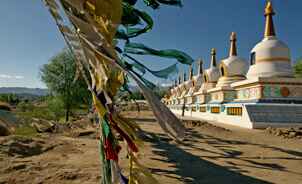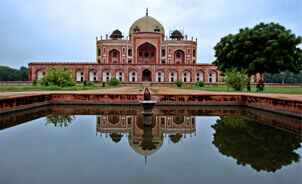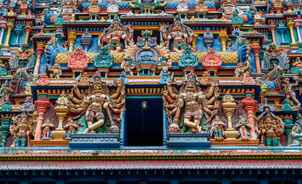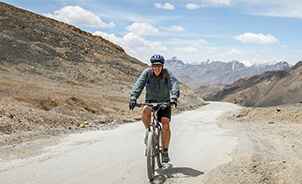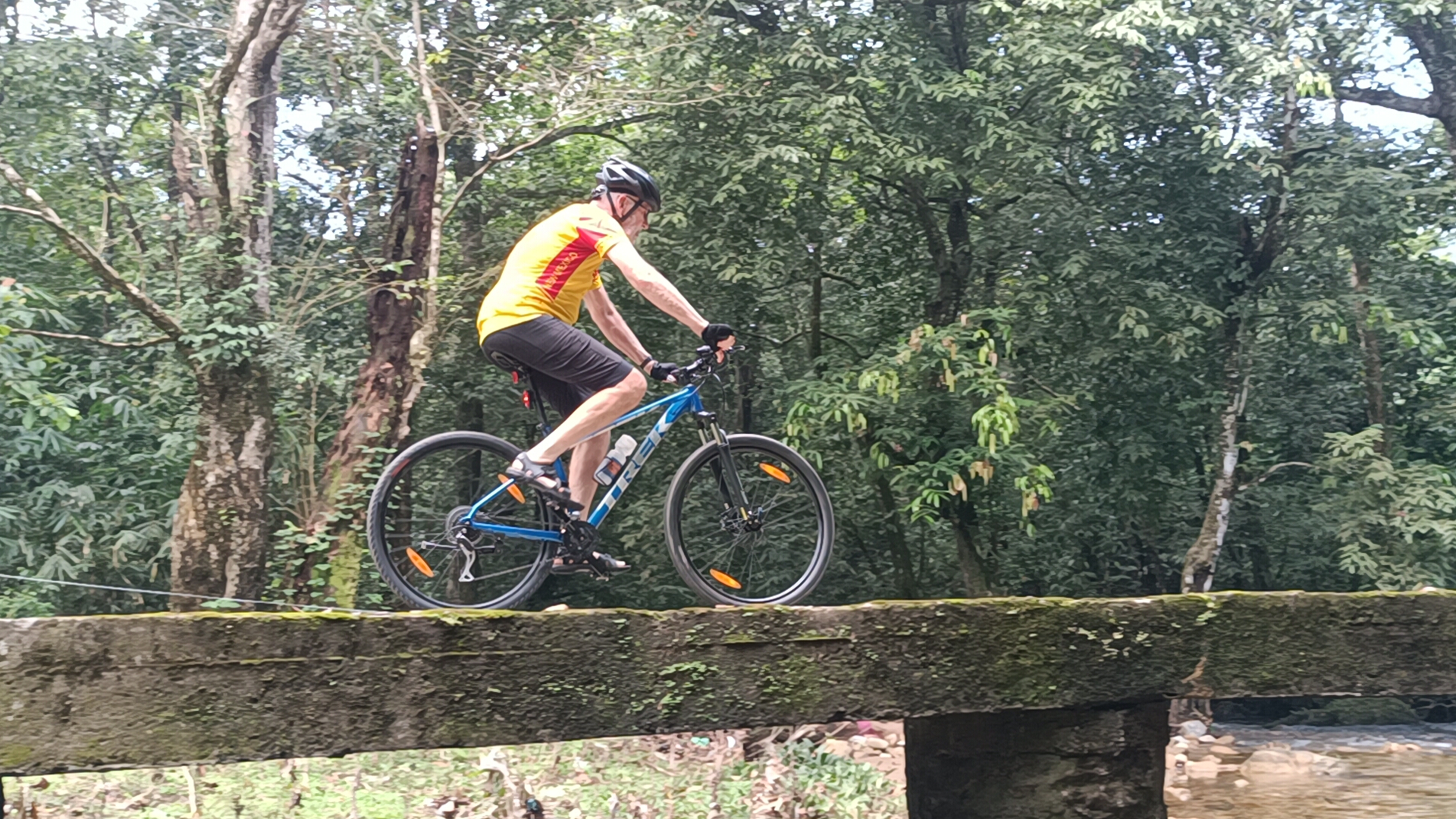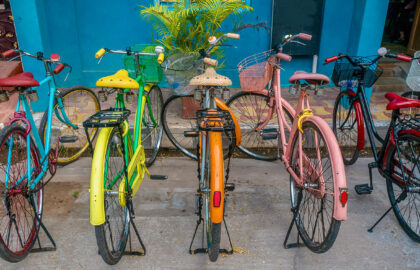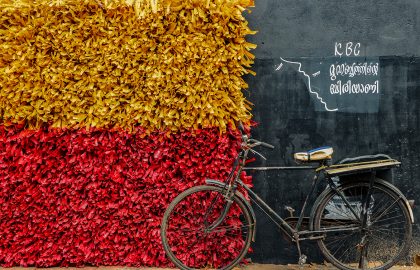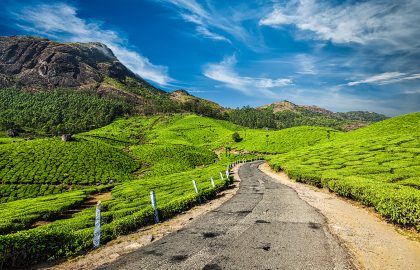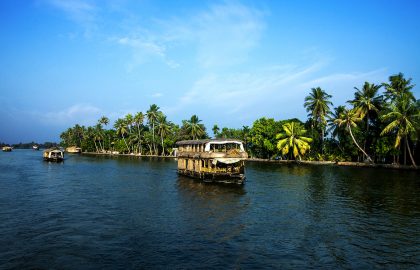Signing up for a cycle tour with Cycling in India is always a remarkable and rewarding experience. Riding across India’s diverse landscapes is an amazing opportunity to explore, connect and savour the beauty of the country. This time, I found myself cycling through the mesmerizing south Indian state of Kerala, touted lovingly as God’s Own Country. Its unique geographical landscape and vibrant culture bring in visitors from across the world. From the quaint suburbs of Fort Kochi, the backwaters of Alleppey, the tea plantations surrounding Munnar and the cardamom hills in Periyar to the forest reserves in the Western Ghats, Kerala is the perfect destination to explore on the humble bicycle.
Through our 10-day cycling expedition, we rode from the coastal city of Kochi to the bird sanctuary area of Thattekad. Cycling along the Periyar River, we then reached the gorgeous hill station of Munnar. Our day in Munnar was spent visiting the local markets and tea plantations. From Munnar, we pedalled on to Periyar on hilly and steep roads while gazing at the Lockheart gap which housed countess tea plantations and spice farms, where we indulged in a visit to the vanilla, cardamom and other spice cultivations. We then descended into the town of Vagamon famous for its scenic views and picnic spots. Our ride to Kumarakom, the backwater town of Kerala was adventurous as we rode past mangrove forests and rice paddy fields. Cycling around the backwaters, we reached the backwater capital of Alleppey, where we spent a day on the houseboat and explored the surrounding region on our bikes.
As we completed a whole loop into Kochi, we were left with lasting memories of an epic 10-day cycling tour across the great state of Kerala.
Day 1: Kochi – Exploring Fort Kochi’s Rich History

As we arrived in Kochi, Cycling in India greeted us with a pick-up service at the airport. We checked into our pre-booked hotel in Fort Kochi and rested up. After breakfast, we were introduced to our tour guide team and got a final brief of our next 10 days across Kerala. Through the afternoon, we cycled through Fort Kochi and explored its rich heritage dating back to the 1400s. The Chinese Fishing Nets are a testament to the city’s long-standing maritime history which provides a picturesque backdrop against the sea. We also delved deep into the vibrant art scene by visiting countless street galleries and art cafes. Cycling across Kochi, we also visited the famous synagogues and shopped for some antique artefacts in Jew Town. Since Kochi is also known for its historic architecture, we also visited the magnificent Santa Cruz Basilica and St. Francis churches. As our day of cycling through history came to an end, the entire group convened at Princess Street to enjoy some great dinner and dessert.
Day 2: Kochi to Thattekad – Into the Green Countryside

As we left Kochi, we started to leave the humidity behind and gaze upon the green countryside scenery. The smooth roads and highways towards Thattekad were lined with coconut, rubber and spice plantations making our ride calm and comfortable. As we neared our destination, we were told that Thattekad being an evergreen lowland forest habitation, is the richest natural bird habitat in India. It houses some of India’s most unique birds that are loved by ornithologists and bird enthusiasts. Since some of the group decided to rest up at the quiet lodge, I decided to take a short detour through the Salim Ali bird sanctuary. While I did not get to witness any exotic birds like the Indian Pitta, the Orange-headed thrush or the yellow-browed bulbuls, I did get to see a lot of Indian cuckoos flying about. After cycling through zero traffic and only the serenade of a thousand birds around me, I returned for a quiet evening in the forest lodge in Thattekad to get a good night’s sleep for a long and arduous ride to Munnar tomorrow.
Day 3: Thattekad to Munnar – Reaching the Hills
As we woke up to the sound of birds chirping in the distance, we called for a healthy and nutritious breakfast that would power our ride up the hilly roads towards Munnar. India’s largest tea plantations are located in Munnar at an altitude of 1,500m offering a breathtaking view of lush green rolling hills and tea bushes. We cycled along the Periyar River and vast tea plantations on a relatively easy stretch of rolling terrain until we came up the hilly climb towards Munnar. As the roads got narrower and meandered across the hills, we were faced with lakes, canyons and narrow gorges on both sides and dense traffic up the climb. But what made this section special was that we could smell the spices and teas in the hills. The final section of the climb into Munnar was very steep, hence we were offered to hitch a ride in the support vehicle or make it up there on our own into town. I decided to get off my bicycle and ride in the support vehicle straight to our boutique hotel in central Munnar.

Day 4: Munnar – Tea and Spice are All Nice
It was a great day to explore Munnar on a bicycle. The landscape around Munnar is littered with national parks and forest reserves known for its flora and fauna. We rode to the Eravikulam National Park, on our way to Marayoor on the outskirts. We then took a small detour to the Mattupetty Dam, hoping to catch a glimpse of elephants that flock to the surrounding areas. After taking plenty of photographs of the gorgeous scenery around us, we opened our packed lunches, gorged them down and cycled on towards Marayoor where we were surrounded by sandalwood forests and ancient dolmen that date back to the early years of humankind. We also visited the famous TATA Tea plantation and indulged in some delicious chai at the local tea stall. It’s Munnar’s rolling terrain and countless viewpoints that made cycling here so mesmerising. The crisp air and cleanliness of the region helped us appreciate this serene landscape even more and the best parts were yet to come.
Day 5: Munnar to Periyar – Gazing at the Greenery
As we cycled out of Munnar, we first stopped at the Lockheart Gap. A picturesque viewpoint offering a bird’s eye view overlooking Bison Valley and the vast expanse of tea plantations and forests below. The mountains in the distance made us truly appreciate the landscape and how cycling in the wilderness is a once in a lifetime experience. As rode on through the forests and winding mountain roads, we came across signs of animal crossings. Apparently, elephants are abundant in the area and are often found wandering the roads and nearby villages. We then passed by a village called Vandanmedu which we were told is the start of the spice region of Kerala. The hills around Vandanmedu, stretching towards Periyar are lined with spice plantations of cardamom, oregano, basil, mint, thyme and even vanilla. The altitude and the crisp air make cultivation of these spices and herbs easier. Additionally, the town hosts one of the largest auctions of cardamom in the city centre during the winter months adding to the commercial vibe of this small hilly forest town. As we reached Periyar, we left our bikes at the home stay organized for us by Cycling in India and took a small walking tour of the spice plantations to indulge in how these spices are cultivated.
Day 6: Periyar to Vagamon – Mixing Spice and Spirituality

Riding out of Periyar has got to be one of the most fantastic rides ever. It was a continuous descent for about 10 kms without any bumps, potholes, speedbreaker and even traffic! The area around Vagamon and Kuttikanam are studden with meadows, pine forests, waterfalls and tea estates and often touted as the best hill stations in Kerala. Vagamon is famous for the chain of 3 beautiful hills called Thangal hill, Murugan hill and Kurismala which gives out a secular religious aura and enchanting feel. Although our ride to Vagamon was short, we were given the opportunity to explore the 3 hills with a tour guide for the day. We even relaxed in the famous Vagamon Meadows famous for film shoots because of its beauty. As our day came to an end, we we shacked up in a forest homestay surrounded by spice plantations and green forests.
Day 7: Vagamon to Kumarakom: Canals like Venice
It was hard to say goodbye to Vagamon. The enchanting hills and spice plantations really made us feel spiritual and one with nature. As we leave the hills behind in Vagamon, we descend slowly into flat lands of Kerala, where we come across mangrove forests and swathes of rice paddy fields. Before reaching Kumarakom, we took a small detour through the city of Kottayam, renowned for its ancient European architecture and Syrian Christian Churches which were built in the late 1500s. As we entered this historical city, it was quite evident in the buildings that this was a place of literature and education. Kottayam is also called “the City of Letters”, as many of the first Malayalam daily newspapers and publishing houses were started and are headquartered here. As we reached Kumarakom, we were amazed by the intriguing network of canals and waterways. The longest lake in India and the largest lake in Kerala, Vembanad Lake borders three major districts in Kerala and is home to many boathouses, festivals, bird sanctuaries and even hosts annual boat races. In Kumarakom, we were treated to a canoe ride in one of the canal networks which made us feel like we were in Venice, except without the brick buildings around us. On this boat ride, we also got to learn of the people who reside here and their daily lives involving fishing, their customs and lifestyles. Our time in Kumarakom culminated by a lovely evening on a houseboat with some delicious Kerala sea food.
Day 8: Kumarakom to Allepey – Houseboat Stay in Alleppey

Our ride from Kumarakom to Allepey did not involve any cycling, rather a short ferry ride across the lake to our houseboat stay across the lake in Alleppey. For our day in Alleppey, we got to take our bicycles on the boat. Cruising through the backwaters around Alleppey, the houseboat rows gently up the water past quaint villages, rice paddy fields, churches and old houses. Our boat ride took us to the nearby towns of Kuppapuram, Kainakry, Chennamkary, Nedumudy and Pulinkunnu. These towns are known for some of the most nutritious and delicious sea food is found in the waters around Alleppey and Kumarakom. We then cycled further inland and visited the famous Chavara Church where a famous beacon light 250 years old is still well preserved. At the end of the our short bike tour of the backwaters, we cycled back to Alleppey by taking the longer route passing through small hamlets, coconut graves, and rice paddy fields. It was a day to reminisce as we settled in to our houseboat for the night.
Day 9: Alleppey to Fort Kochi – Our last ride in God’s Own Country
Our last day of cycling in Kerala involved a slow ride from Alleppey to Fort Kochi on relatively flat terrain and a beautiful coastal highway for approximately 50 kilometres. We reached Fort Kochi in the afternoon and checked in to our hotels and freshened up for a light evening of fun at the hotel organised by Cycling in India.
The following morning, we checked out of our hotel and headed towards the airport in our pick up transport taken care of by the hotel and our tour guides.
As we departed Kochi, we saw the crisp coastline and the serene backwaters from our windows reminiscing our amazing cycling tour across God’s Own Country.

